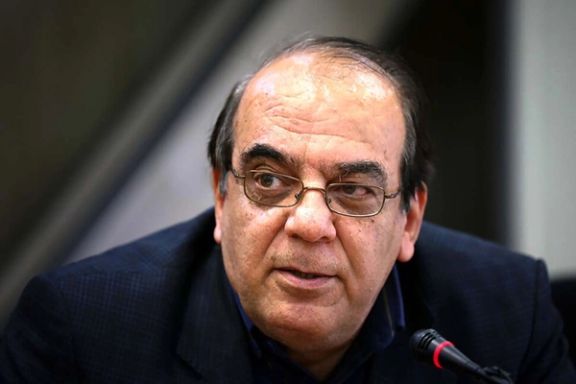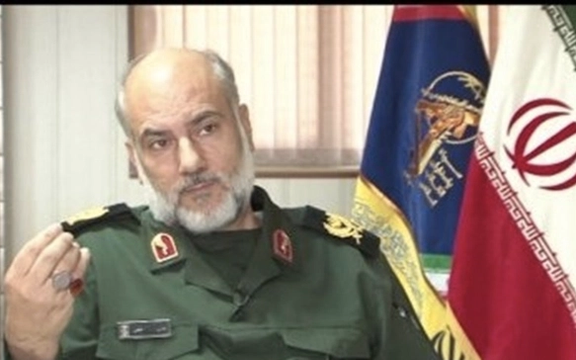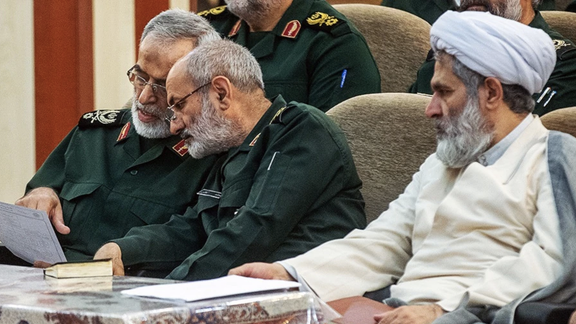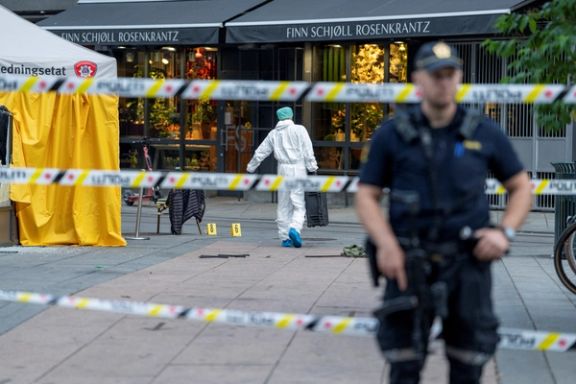Iran To Unveil Air Defense Missiles With 300km Range

Iran’s Air Defense Force has announced plans to unveil missiles with a range of 300 kilometers to increase the country’s “deterrent power.”

Iran’s Air Defense Force has announced plans to unveil missiles with a range of 300 kilometers to increase the country’s “deterrent power.”
Addressing a gathering of the officers of the Armed Forces, the Revolutionary Guard and the police on Sunday, Deputy Commander of the Army’s Air Defense Force, Brigadier General Alireza Elhami said "The only way out of all sanctions and threats is to become stronger in all matters, especially in the military field."
The development of missile power is a sign of self-confidence and reliance on domestic capabilities, he added, without disclosing any details about the new missiles.
He also called for synergy and coordination between the various branches of the Islamic Republic’s military, describing it as a force of progress for the country.
“The Army Air Defense is cooperating with the country's elites, the Ministry of Defense, and the Armed Forces in the fields of defense sciences, artificial intelligence, cognitive sciences, quantum physics, cyber defense, and electronic warfare,” Elhami said.
Late in May, Iran showcased several new models of cruise missiles and drones in an Army's secret underground base in the Zagros mountains.
Iran is accused of providing Yemen’s Houthis and numerous other proxies militias with missiles and drones that are used to attack Saudi Arabia and the United Arab Emirates as well as bases hosting US-led forces in Iraq and Syria.

Tehran's Prosecutor Ali Salehi says the number of complaints made against Iranian media has risen by 50 percent since March, mostly by government entities.
He added that during the past year out of 319 complaints, 39 cases have led to arrests and indictments of which, 20 media outlets or journalists have been convicted of various offenses and 19 have been cleared of the charges.
He added that most of the charges included publishing lies, libel and insult and in most cases a settlement has been reached through payment of fines.
Pressures on the press have been on the rise during the past months. Maryam Shokrani, a Shargh daily journalist, wrote in a tweet on June 25 that these include fabrication of cases against journalists in a systematic way. Sher wrote in another tweet the previous day that the Oil Ministry in Iran forced her to pull a story about an Iran vessel seized in international waters.
Developments indicating more pressures on the media and journalists, coincided with a meeting by journalists on Thursday where they discussed "the national media document," which highlights the need for regulating media activities and relations between the government and the media.
According to the reformist Shargh, the meeting was called by board of directors of the Tehran Province Press Association which operates as a proxy for the Journalists and Writers Trade Union, banned for nearly a decade now. The association's board members, as well as several journalists, editors, academics and cultural figures took part in the meeting.

Board chairman Abbas Abdi, a reformist journalist said that the national media document includes suggestions by the association to improve the situation of the media. He added that by offering this collection of suggestions, the association wishes to start a dialogue between with the government.
Abdi said: "Any change in Iran should start from the media. And by the word media, I mean the official media rather than unofficial [social] media." Abdi added that four group of journalists representing the print media, radio and television, social media, and news agencies have worked on the document which generally explains the status quo and offers a prospect for the future.
Academic Mehdi Mohsenian Rad said newspaper readership is very small in Iran, judging by limited circulation. He further explained that the reason for this problem is that "There is political control on the press that aims to promote the official values of the government."
Mohsenian added that the Iranian government does not recognize the role of the media as a body that monitors the behavior of various actors in society.
Economist Kamal Athari said that the problem of the media starts from the government's approach to social and economic development. In the Iranian press everything is about power rather than progress and this has been the case since the 1990s.
Ali Mirzakhani, who has been the managing editor of the economic daily Donyaye Eqtesad, confirmed Mohsenian's view about the prevailing ideological approach to media content in Iran. Nonetheless, he argued that government control over the media starts from the requirement of receiving a license to start a media venture. Anyone who cannot be trusted to follow the ideological and political boundaries of the Islamic Republic cannot receive a license to publish.
Mirzakhani also mentioned the role of cash subsidies paid by the government to the press as a tool for controlling the media. This attracts publishers who have the right connections, but no professional interest, and wish to work with journalists whose main characteristic is obedience rather than expertise, said journalist Mojgan Jamshidi.

A banner of Iran’s Supreme Leader Ali Khamenei and Islamic Republic’s founder Ruhollah Khomeini was set on fire in the central city of Yazd.
A video of the incident on Saturday went viral, showing the pictures of Khomeini and Khamenei burning on top of an overpass in the city, a scene recurring frequently especially since the popular protests gained momentum across the country on the backdrop of rising prices and a falling currency.
Several pictures and statues of the Islamic Republic leaders and important figures have been set on fire in recent months as anti-government protests and strikes have taken place on a regular basis in many cities throughout the country.
Statues and pictures of Khomeini, Khamenei, and President Ebrahim Raisi as well as the slain IRGC Quds Force Commander Qasem Soleimani are the top targets for the political vandalism in cities such as Tehran, Esfahan, Yazd, Qom, and Kermanshah.
According to an online survey by a Netherlands-based institute, over 60 percent of Iranians want regime change or "transition from the Islamic Republic".

The head of the IRGC's unit responsible for the Supreme Leader’s protection was replaced two days after the dismissal of its intelligence chief, Hossein Taeb.
In a statement Saturday, the IRGC Spokesman Ramezan Sharif announced that Brigadier General Hassan Mashruifar has been appointed as commander of an elite IRGC unit, Sepah-e Vali-ye Amr (Supreme Leader’s [Protection] Corps, by the IRGC Commander-in-Chief Hossein Salami.
The statement also said Salami awarded the former commander of the protection unit, Brigadier General Ebrahim Jabbari with a certificate of appreciation for his services. Jabbari served as Taeb’s deputy when he headed the IRGC’s militia organization (Basij) before he was appointed as the IRGC intelligence chief.
Sepah-e Vali-ye Amr is one of the subsidiaries of the IRGC’s Intelligence Protection Organization (Sazeman-e Hefazat-e Sepah). Sepah-e Vali-ye Amir is solely responsible for protection of the Supreme Leader and was officially established in mid-1980s and is believed to consist of as many as 12,000 highly trained forces.
Although many consider Ta’eb’s replacement after 13 years at the helm of the IRGC Intelligence Organization (SAS) as ‘dismissal’, for reasons not yet revealed, media linked with the IRGC on Saturday downplayed the importance of Ta’eb’s removal and claimed that replacing him was a step towards an “intelligence onslaught on the enemy” and an “increase in operations against Israel” by the SAS.

Replacing Ta’eb, a mid-ranking cleric with a military background, with an IRGC general signals “restructuring for a new era and as a step forward”, the IRGC-linked Tasnim news agency wrote. This means that Iran can take “further steps against the ambitions of the United States and Israel,” Tasnim said, adding that Ta’eb will be contributing to the restructured organization as an adviser to the commander-in-chief of the IRGC.
The title of adviser is often given to officials in Iran after dismissal to protect their reputations and not to admit that the persons in question made mistakes or were not fit for the positions they occupied.
The IRGC-linked Javan newspaper called the appointment of Brigadier General Mohammad Kazemi, referred to by his nom de guerre Haj Kazem, as “injection of new blood” into SAS to fight against “foreign enemies, their lackeys and mercenaries, and hostile elements [political activists and organizations]”.

Sources familiar with the situation have told Iran International that Taeb was replaced due to long-simmering opposition by other top security figures, including the chief commander of IRGC’s Quds (Qods) Force Esmail Ghaani (Qaani) and Esmail Khatib, the minister of intelligence.
They also said Ta’eb’s high-ranking opponents argued that his organization did not use “the elementary standards for neutralizing terrorist activities” in Iran and charged that the recruitment of “amateurish and non-professional” elements in extraterritorial operations harmed Iran’s other security entities.
Jamshid Barzgar, journalist, told Iran International on Saturday that changes in the SAS leadership will not be effective against the intelligence operations conducted by Israel inside Iran.
According to Barzgar, the revelation of plans to dismiss Ta’eb by Israel’s KAN television several days before its announcement in Iran is a sign of deep penetration by Israeli intelligence in Iran, which has caused huge concern of various officials regarding their own safety and security in the face of Israeli threats.
The reason for Ta’eb’s dismissal is due more to disputes and disagreements inside the Iranian intelligence bodies rather than his inefficiency in dealing with foreign threats or carrying out operations, Barzgar said, adding that his successor has also been responsible for all these failures.
The Islamic Republic has two major intelligence organizations: the Ministry of Intelligence and the IRGC Intelligence Organization (SAS in Persian acronym). The ministry nominally is under the president’s control and regards itself as the most professional entity. But in fact, it is also controlled by Khamenei, who selects the minister.

Iraqi Prime Minister Mustafa al-Kadhimi is scheduled to visit Iran after Saudi Arabia, an informed source has said.
Iraq's Shafaq News Agency quoted the source as saying that al-Kadhimi would visit Iran within 24 hours after participating in the Riyadh summit.
Relations between Iran and Saudi Arabia as well as Iraq’s parliamentary reconfiguration following the mass resignation of the Sadrist bloc will probably be on the agenda of the Iraqi premier’s visit.
Iran and Saudi Arabia -- which are locked in proxy conflicts around the region -- have held several rounds of talks in the Iraqi capital Baghdad since 2021 to improve their ties, severed since 2016, with no major results so far.
On Thursday, Iraq's parliament swore in dozens of new lawmakers, enlarging the Iran-backed bloc in the assembly about two weeks after a group of 73 parliamentarians loyal to the powerful Shiite cleric Moqtada al-Sadr resigned on June 12 upon his order following eight months of stalemate over forming a new government.
Last week, Iraqi Foreign Minister Fuad Hussein criticized the Islamic Republic's interference in Iraq's internal affairs. He also said earlier this month that Baghdad had submitted a formal complaint to Iran for its aggressive behaviors toward Iraq and the Kurdistan Autonomous Region, and denied Iran's allegations that the Israeli Mossad is present in Erbil.
In March, Iran fired missiles at Erbil, claiming it used 12 ballistic missiles in that attack and targeted an Israeli intelligence center.

A Norwegian-Iranian man embarked on a shooting spree in a gay bar and the surrounding streets in Oslo on Saturday, killing two people and injuring more than 20.
The rampage took place inside and outside the London Pub, a well-known gay bar and nightclub open since 1979, as well as at one other bar in the center of the Norwegian capital in the early hours of the day as the city's LGBTQ+ community was due to celebrate its annual Pride parade, which is now called off upon police recommendations.
The 42-year-old suspect, identified as Zanyar Matapour, was detained minutes after the attack, according to police who said they believed he acted alone. Two weapons, a pistol and a fully automatic rifle, were retrieved from the crime scene.
"There is reason to think that this may be a hate crime. We are investigating whether the Pride was a target in itself or whether there are other motives," police said, adding that the man was “suspected of murder, attempted murder and terrorist acts.” “The attack was also being investigated as “a possible act of terrorism.”
Norwegian police, who are not normally armed, will now carry guns until further notice as a precaution, Commander Benedicte Bjoernland said. Norway's PST intelligence service said that it was investigating whether there could be further attacks.
The Nordic nation of 5.4 million has lower crime rates than many Western countries, although it has experienced hate-motivated shootings, including when Neo-Nazi extremist Anders Behring Breivik killed 77 people in 2011.